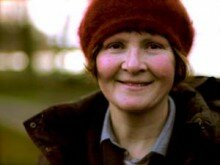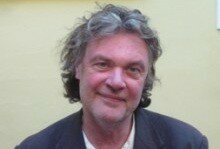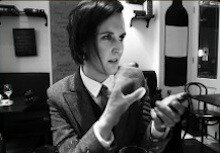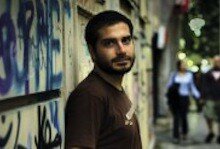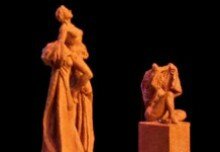On ‘The One Who Came After Me’
Gouri sees the way religion threatens Israeli culture and doesn’t shrink from calling it ‘barbaric’.
The title poem (and the last) in Chaim Gouri’s collection The One Who Came After Me [1994] opens with the lines: “I’m no longer the man who was. I’m the one who came after me,/ an imagined extension of the same face”. This puzzling poem has been understood, not with the seriousness it deserves, to be about aging. In the poem, [the now-82-year-old] poet offers himself as someone dragged behind the person he once was. But there are signs in the verse that this approach is a misunderstanding: “I’m going on without him.” Who is this self who walks without the “man who was”? How may we understand the Other who “came after”?
[In 1998], Gouri’s Collected Poems appeared, providing a brilliant answer to this question: at the end of the second volume may be found a group of poems under the heading “Late Lookout”, a previously unpublished continuation of “The One Who Came After Me” written in 1995-1997. In “Late Lookout” the wingspan of the new Chaim Gouri is revealed. Not Other and yet Other; a long, uninterrupted process of development has ripened the fruits of his poetry, presenting us with a daring and powerful lyric tone, with rare emotional impact. Gouri’s poetry suddenly connects to the world, which is laid bare; Gouri begins to make use of his visual acuity, which had always bordered on prophecy, and its riches shine through his poetry in a way they have never shone before.
“The one who came after” represents, therefore, a different ‘I’, an inner and secret self, which developed until the former ‘I’ made room for and identified with it. There is nothing further from this than a [standard] position on aging: a coming to terms with temporality. Gouri presents a rare human and artistic model of an artist / a person who experiences a transformation, who has undergone a complete transfiguration into the Other, which existed within, and is as though reborn into a new era of self. Old age, instead of “days without desire”, becomes a treasure – an attitude which is unique, sharp and daring.
It would be a mistake to underestimate the poetry that preceded “Late Lookout”. Gouri's earlier poetry did not merely change and develop, but also aspired to something previously unknown and unimagined, a state which could have been reached only unconsciously. This ‘unconsciousness’ is the consummate symbolism of reality. Perhaps another word is in order: the gargantuan symbolism of reality. Or a few more: the sheer, unmitigated symbolism of reality. Here, for example, is a short poem from “Late Lookout”, called “Sand Castles”:
You recall,
it’s like the wave in the afternoon,
which flooded our sand castle,
the tunnels and the towers of the fort,
patience and shells and driblets of sand,
decorative additions.
And it didn’t know.
Barbarism will return.
Insensitive to precision, not backward.
Thinking big.
A simple symbolic fiction is located between culture and barbarism in this poem. The force and silt of the wave represent the extant, permanent power of barbarism. Culture is represented by a palace, and a fort which is more beautiful than practical. The fort’s imagined enemies are meaningless in comparison with the real enemy – the sea. Moreover, the origin of both palace and fort is in the sea. Sand and water come from the sea and lie on the shore. Each detail in this picture, even the most trivial, adds to the parable about culture. Culture in its purest form is a game, a game in the guise of life. The game contains a hierarchy (a castle), enemies (a fort) and mystery (tunnels) in an imitation of nature which minimizes and collects it as decorative treasure (the shells and driblets of sand). And culture is made with artistry and seriousness. (Patience) is the seriousness of a child playing at the beach, to whom the destruction inherent in the waves, the approaching evening, and all the other endings remain outside the perfection of his task. But Gouri adds a local mark, connected to the Hebrew language, to the parable, painting the hostility between sea and culture in the contemporary colors [of Israel]: The castle is made of sand, “xol” in Hebrew, which also means “profane”, not sacred, day-to-day. From this point of view, barbarism now becomes holy. All culture is profane, the work of human beings, their wisdom and patience. The exemplars of beauty and play are neither godly gifts nor religious obligations. Sometimes culture serves religion (medieval Jewish poetry and the sculpture of Michelangelo) but even these examples come to the world from a secular direction; religious culture and art contain a contradiction between beauty and humanity on one side and religious purposes on the other.
The word “sand / profane” in this poem connects it to the experience of life in Israel at this time; Gouri perceives and shows the way religious Judaism threatens Israeli culture and he doesn’t flinch at calling it “barbaric”. He defines its attributes: “Insensitive to precision, not backward./ Thinking big.” The most important of these is “not backward”. Backward has two meanings: in time and in development. Barbarism isn’t tied to the past; it does not remain in the past. It is alive and kicking, chasing close on the heels of culture. It is part of culture. Barbarism isn’t primitivity, roughness and lack of skill in the wonders of technology. It is reminiscent of culture almost in every aspect, except for one fatal difference: it isn’t sensitive to small differences and thinks “big”. Only big. Not details (and people as individuals), not the tiniest detail, and certainly not style, quality and anything included in “precision”. Its power is Stygian, it carries things away with the power of the sea. It contains the characteristics of true nature, of unchained nature in man. Gouri does not shrink from the clash between secular and religious culture in Israel and he faces it from the direction of secular culture. He does not feel any guilt and he does not try to paint religious Judaism as culture; he does not hide his preference for and involvement in secular culture, as he does not hide his feeling that its power is the power of the sand castle over that of the sea.
Translated for PIW from an article appearing in the Israeli literary monthly Moznaim August 1998, 11:12-13Lines from “The one who came after me” translated by Stanley Chyet, from Words in my Lovesick Blood Publisher: Wayne State University Press, 1996


